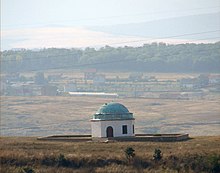Murad I.
Murad I. (مراد بن اورخان / Murād b. Orḫān ; * 1319 or 1326 ; † 1389 in the battle on the Amselfeld ), calledغازى خنكار / Ġāzī Ḫünkār andخداوندگار / Ḫüdāvendigār , was Sultan of the Ottoman Empire from 1359 to 1389 .
Origin and character
Murad was the fourth of six sons of Orhan I. His mother Nilüfer Hatun was the daughter of a Byzantine governor. Murad was of a self-reliant character and remarkable intelligence. After being deported to the command of a distant province in Asia for a long time, while his brother Suleyman had an enviable position in Europe, he became vengeful. He demonstrated great cruelty in suppressing a rebellion by his son Savci (the first time a sultan's son raised arms against his father).
government
As the first Ottoman monarch, Murad was able to gain a permanent foothold in Europe ; the main goal during his career was to expand the European dominion of the empire. The Prince of Karaman's rebellions hampered this plan, and on more than one occasion he encountered problems from this direction, until the final battle of Konya broke the power of the Karaman.
The state of Europe played into Murad's hands: civil war and anarchy prevailed in most of the countries of Central Europe, where the feudal system was at its last; the small Balkan states were divided by mutual jealousy. The capture of Adrianople in 1363, to which he then renamed Edirne, followed by further conquests, brought together a coalition under the King of Hungary , but his able general Lālā Shahin, the first Beylerbey of Rumelia , defeated the allies in the Battle of the Mariza in 1371. In 1366 the King of Serbia was defeated at Samakowo and forced to pay tribute; a resumption of war in 1381 led to the conquest of Sofia ( Bulgaria ) two years later.
Murad moved the Ottoman seat of government from Bursa to Adrianople, which had been wrested from the Byzantines, and renamed it "Edirne". From then on he used it as the capital of his expanding empire, built a palace there and had the entire city beautified.
Europe was now shaken. Lazar Hrebeljanović , a Serbian prince , formed a Christian alliance against the Turks. Murad hurried back to Europe and met his opponents in Kosovo (see Battle of the Blackbird Field ). After initial confusion, the victory finally leaned towards the Turkish side. A Serbian nobleman named Miloš Obilić stabbed Murad in the course of the battle. According to legend, he came into the Turkish camp injured and pretended to be overflowing. At an opportune moment he rammed a previously hidden knife or short sword into Murad's torso. Murad's internal organs are buried in the Meşhed-i Hüdavendigar, a mausoleum about 10 kilometers from present-day Pristina .
The development of the Tımar system and its expansion into Europe was essentially his work. When Murad became Sultan, the Ottoman Empire was 95,000 km². Thirty years later, the Ottoman Empire had five times the area with 500,000 km².
Most historians believe that Murad is also the founder of the military formation of the Janissaries . The foundation is classified by these in the years between 1365 and the end of the 14th century.
literature
For article creation
- Peter Furtado (project leader), The New Atlas of World History , Chronik Verlag, 2007
further reading
- Ferenc Majoros, Bernd Rill: The Ottoman Empire 1300-1922. The story of a great power . Marix, Wiesbaden 2004, ISBN 3-937715-25-8 .
- Josef Matuz: The Ottoman Empire. Baseline of its history . 4th edition. Scientific Book Society, Darmstadt 2006, ISBN 3-534-20020-9 .
- Gabriel Effendi Noradounghian : Recueil d'actes internationaux de l'Empire Ottoman 1300–1789. Tome I. Paris, Neufchâtel 1897. Reprint: Kraus, Nendeln 1978, ISBN 3-262-00527-4 .
- Anton Cornelius Schaendlinger: Murad I. . In: Biographical Lexicon on the History of Southeast Europe . Volume 3. Munich 1979, pp. 245-248
Web links
- http://www.tuerkenbeute.de/kun/kun_bio/Murat1_de.php Badisches Landesmuseum, Karlsruhe: Murat I.
Individual evidence
- ^ Leslie P. Peirce: The Imperial Harem. Women and Sovereignty in the Ottoman Empire . New York et altera 1993, pp. 34f; Franz Babinger: Nīlūfer KHātūn. In: Encyclopaedia of Islam, Second Edition . Edited by: P. Bearman, Th. Bianquis, CE Bosworth, E. van Donzel and WP Heinrichs. Brill, 2009.
- ↑ See Patrick Kinross: The Ottoman Centuries. The Rise and Fall of the Turkish Empire . London: Perennial, 1977, ISBN 978-0-688-08093-8 , pp. 48-52.
| predecessor | Office | successor |
|---|---|---|
| Orhan I. |
Sultan of the Ottoman Empire 1359–1389 |
Bayezid I. |
| personal data | |
|---|---|
| SURNAME | Murad I. |
| ALTERNATIVE NAMES | Khudavendighiar |
| BRIEF DESCRIPTION | Sultan of the Ottoman Empire (1359-1389) |
| DATE OF BIRTH | 1319 or 1326 |
| DATE OF DEATH | 1389 |
| Place of death | Blackbird field |



